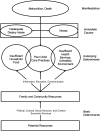Responsive feeding and child undernutrition in low- and middle-income countries
- PMID: 21270354
- PMCID: PMC3040907
- DOI: 10.3945/jn.110.130005
Responsive feeding and child undernutrition in low- and middle-income countries
Abstract
Growth faltering and nutritional deficiencies continue to be highly prevalent in infants and young children (IYC) living in low- and middle-income (LAMI) countries. There is increasing recognition that feeding behaviors and styles, particularly responsive feeding (RF), could influence acceptance of food and dietary intake and thus the growth of IYC. This paper presents the evolution of RF research and the strength of the evidence for RF on child undernutrition in LAMI countries. Multiple approaches were used to identify studies, including keyword searches in many databases, hand searches of retrieved articles, and consultation with experts in the field. Articles were included if they contained a RF exposure and child undernutrition outcome. In total, we identified 21 studies: 15 on child growth, 4 on dietary intake, 3 on disease, and 8 on eating behaviors. Most studies were conducted among children <36 mo of age and were published in the last 10 y. Cross-study comparisons were difficult due to multiple definitions of RF. One-half of the studies were observational with cross-sectional designs and few interventions were designed to isolate the effect of RF on child undernutrition. Overall, few studies have demonstrated a positive association between RF and child undernutrition, although there is promising evidence that positive caregiver verbalizations during feeding increase child acceptance of food. Recommendations for future research include consensus on the definition and measurement of RF, longitudinal studies that begin early in infancy, and randomized controlled trials that isolate the effect of RF on child undernutrition.
Conflict of interest statement
Author disclosures: M. E. Bentley, H. M. Wasser, and H. M. Creed-Kanashiro, no conflicts of interest.
Figures
References
-
- UNICEF Tracking progress on child and maternal nutrition: a survival and development priority. New York: UNICEF; 2009
-
- Engle PL, Menon P, Haddad L. Care and nutrition: concepts and measurement. World Dev. 1999;27:1309
-
- Engle PL, Zeitlin M. Active feeding behavior compensates for low interest in food among young Nicaraguan children. J Nutr. 1996;126:1808–16 - PubMed
-
- Gittelsohn J, Shankar AV, West KP, Jr, Faruque F, Gnywali T, Pradhan EK. Child feeding and care behaviors are associated with xerophthalmia in rural Nepalese households. Soc Sci Med. 1998;47:477–86 - PubMed
Publication types
MeSH terms
Grants and funding
LinkOut - more resources
Full Text Sources
Medical


